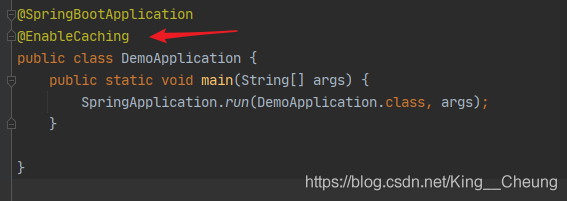Spring Cache Caffeine缓存
Simon西蒙 人气:2一、前言
Spring Cache本身是Spring框架中一个缓存体系的抽象实现,本身不具备缓存能力,需要配合具体的缓存实现来完成,如Ehcache、Caffeine、Guava、Redis等。
二、缓存注解
- @EnableCaching:开启缓存功能
- @Cacheable:定义缓存,用于触发缓存
- @CachePut:定义更新缓存,触发缓存更新
- @CacheEvict:定义清楚缓存,触发缓存清除
- @Caching:组合定义多种缓存功能
- @CacheConfig:定义公共设置,位于class之上
三、实战操作
我选择使用目前最受欢迎的Caffeine来作为具体的缓存实现方式,下面是一个demo:
1、依赖引入
<dependency>
<groupId>com.github.ben-manes.caffeine</groupId>
<artifactId>caffeine</artifactId>
<version>2.8.6</version>
</dependency>
<dependency>
<groupId>org.springframework.boot</groupId>
<artifactId>spring-boot-starter-cache</artifactId>
</dependency>
2、yaml配置
spring:
cache:
cache-names: USER
caffeine:
spec: initialCapacity=50,maximumSize=500,expireAfterWrite=5s
type: caffeine
Caffeine配置说明
- initialCapacity=[integer]: 初始的缓存空间大小
- maximumSize=[long]: 缓存的最大条数
- maximumWeight=[long]: 缓存的最大权重
- expireAfterAccess=[duration]: 最后一次写入或访问后经过固定时间过期
- expireAfterWrite=[duration]: 最后一次写入后经过固定时间过期
- refreshAfterWrite=[duration]: 创建缓存或者最近一次更新缓存后经过固定的时间间隔,刷新缓存
- weakKeys: 打开key的弱引用
- weakValues:打开value的弱引用
- softValues:打开value的软引用
- recordStats:开发统计功能
注意
- expireAfterWrite和expireAfterAccess同事存在时,以expireAfterWrite为准。
- maximumSize和maximumWeight不可以同时使用
- weakValues和softValues不可以同时使用
3、开启缓存

4、模拟方法
service层
@Service
@Slf4j
public class CaffeineService {
public static Map<String, String> map = new HashMap<>();
static {
map.put("1", "zhangsan");
map.put("2", "lisi");
map.put("3", "wangwu");
}
@Cacheable(value = "USER", key = "#id")
public String getUser(String id) {
log.info("getUser() run......");
return map.get(id);
}
@CachePut(value = "USER", key = "#id")
public String updateUser(String id, String name) {
log.info("updateUser() run......");
map.put(id, name);
return map.toString();
}
@CacheEvict(value = "USER", key = "#id")
public String delUser(String id) {
log.info("delUser() run......");
map.remove(id);
return map.toString();
}
}
controller层
@RestController
@RequestMapping("/cache")
@Slf4j
public class CaffeineController {
@Autowired
private CaffeineService caffeineService;
@GetMapping("/user/{id}")
public String getUser(@PathVariable String id) {
long start = System.currentTimeMillis();
String res = caffeineService.getUser(id);
long end = System.currentTimeMillis();
log.info("查询耗时:" + (end - start));
return res;
}
@GetMapping("/user/{id}/{name}")
public String updateUser(@PathVariable String id, @PathVariable String name) {
return caffeineService.updateUser(id, name);
}
@DeleteMapping("/user/{id}")
public String delUser(@PathVariable String id) {
return caffeineService.delUser(id);
}
}
5、测试
第一次查询:

第二次查询:

查询耗时明显小于第一次查询,因为第二次直接返回缓存,速度提升。
执行更新后再查询:
会使缓存失效。会重新执行查询方法查询

执行删除后再查询:
会使缓存失效。会重新执行查询方法查询

6、改造
上述通过yaml文件配置的方式不够灵活,无法实现多种缓存策略,所以现在一般使用javaconfig的形式进行配置。
下面是示例代码:
@Configuration
public class CaffeineConfig {
@Bean
public CacheManager caffeineCacheManager() {
SimpleCacheManager simpleCacheManager = new SimpleCacheManager();
List<CaffeineCache> caffeineCaches = new ArrayList<>();
for (CacheType cacheType : CacheType.values()) {
caffeineCaches.add(new CaffeineCache(cacheType.name(),
Caffeine.newBuilder()
.expireAfterWrite(cacheType.getExpires(), TimeUnit.SECONDS)
.build()));
}
simpleCacheManager.setCaches(caffeineCaches);
return simpleCacheManager;
}
}
public enum CacheType {
USER(5),
TENANT(20);
private int expires;
CacheType(int expires) {
this.expires = expires;
}
public int getExpires() {
return expires;
}
}
这样我们就能对USER设置5秒消防时间,对TENANT设置20秒消亡时间,在实际项目中这种方式更加的灵活。
加载全部内容